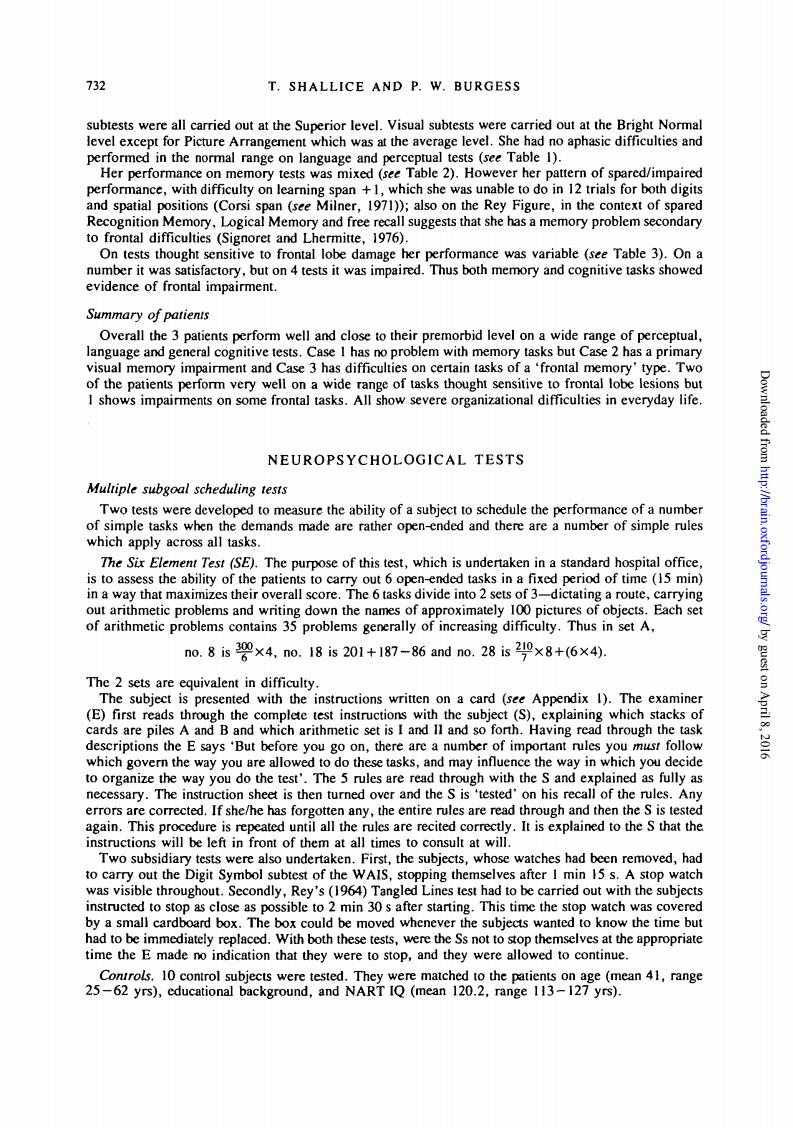正在加载图片...

732 T.SHALLICE AND P.W.BURGESS Summary of patients Overall the I close to thei id level o la al me on some fronta tasks.All show severe organizationa difficulties in everyday life. NEUROPSYCHOLOGICAL TESTS Multiple subgoal scheduling tests which apply across all tasks The Six Element Test (SE).The purpose of this test,which is undertaken in a standard hospital office is to as s in enio e (5 min) tic problems and writ rithmetic problems c n0.8isg×4,n0.18is201+187-86 and no.28is29×8+(6×4). endix 1).The examiner the subject(S xplain nwhich stacks o E品a wed to do th tasks,and may influ the the way in which yo n sheet is then turned over and thes his recall of the rules.Am Two subsidi en removed,had nstructed to stop as cl .This time the stop watch time the E made no indication that they were to stop,and they were allowed to continue. yrs)732 T. SHALLICE AND P. W. BURGESS subtests were all carried out at the Superior level. Visual subtests were carried out at the Bright Normal level except for Picture Arrangement which was at the average level. She had no aphasic difficulties and performed in the normal range on language and perceptual tests (see Table 1). Her performance on memory tests was mixed (see Table 2). However her pattern of spared/impaired performance, with difficulty on learning span +1 , which she was unable to do in 12 trials for both digits and spatial positions (Corsi span (see Milner, 1971)); also on the Rey Figure, in the context of spared Recognition Memory, Logical Memory and free recall suggests that she has a memory problem secondary to frontal difficulties (Signoret and Lhermitte, 1976). On tests thought sensitive to frontal lobe damage her performance was variable (see Table 3). On a number it was satisfactory, but on 4 tests it was impaired. Thus both memory and cognitive tasks showed evidence of frontal impairment. Summary of patients Overall the 3 patients perform well and close to their premorbid level on a wide range of perceptual, language and general cognitive tests. Case 1 has no problem with memory tasks but Case 2 has a primary visual memory impairment and Case 3 has difficulties on certain tasks of a 'frontal memory' type. Two of the patients perform very well on a wide range of tasks thought sensitive to frontal lobe lesions but 1 shows impairments on some frontal tasks. All show severe organizational difficulties in everyday life. NEUR0PSYCH0LOGICAL TESTS Multiple subgoal scheduling tests Two tests were developed to measure the ability of a subject to schedule the performance of a number of simple tasks when the demands made are rather open-ended and there are a number of simple rules which apply across all tasks. The Six Element Test (SE). The purpose of this test, which is undertaken in a standard hospital office, is to assess the ability of the patients to carry out 6 open-ended tasks in a fixed period of time (15 min) in a way that maximizes their overall score. The 6 tasks divide into 2 sets of 3—dictating a route, carrying out arithmetic problems and writing down the names of approximately 100 pictures of objects. Each set of arithmetic problems contains 35 problems generally of increasing difficulty. Thus in set A, no. 8 is 2^x4 , no. 18 is 201 + 187-86 and no. 28 is ^x 8 + (6x4). The 2 sets are equivalent in difficulty. The subject is presented with the instructions written on a card (see Appendix 1). The examiner (E) first reads through the complete test instructions with the subject (S), explaining which stacks of cards are piles A and B and which arithmetic set is I and II and so forth. Having read through the task descriptions the E says 'But before you go on, there are a number of important rules you must follow which govern the way you are allowed to do these tasks, and may influence the way in which you decide to organize the way you do the test'. The 5 rules are read through with the S and explained as fully as necessary. The instruction sheet is then turned over and the S is 'tested' on his recall of the rules. Any errors are corrected. If she/he has forgotten any, the entire rules are read through and then the S is tested again. This procedure is repeated until all the rules are recited correctly. It is explained to the S that the instructions will be left in front of them at all times to consult at will. Two subsidiary tests were also undertaken. First, the subjects, whose watches had been removed, had to carry out the Digit Symbol subtest of the WAIS, stopping themselves after 1 min 15 s. A stop watch was visible throughout. Secondly, Rey's (1964) Tangled Lines test had to be carried out with the subjects instructed to stop as close as possible to 2 min 30 s after starting. This time the stop watch was covered by a small cardboard box. The box could be moved whenever the subjects wanted to know the time but had to be immediately replaced. With both these tests, were the Ss not to stop themselves at the appropriate time the E made no indication that they were to stop, and they were allowed to continue. Controls. 10 control subjects were tested. They were matched to the patients on age (mean 41, range 25-6 2 yrs), educational background, and NART IQ (mean 120.2, range 113-127 yrs). by guest on April 8, 2016 http://brain.oxfordjournals.org/ Downloaded from